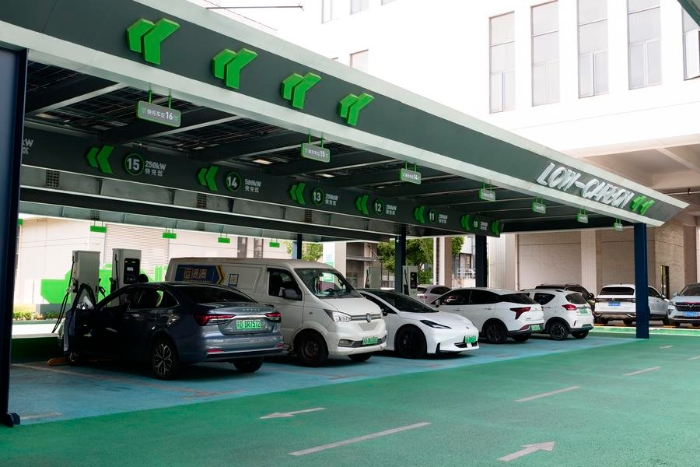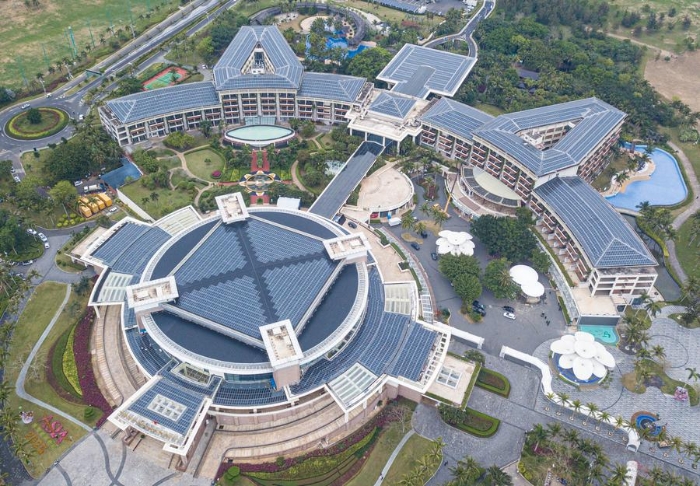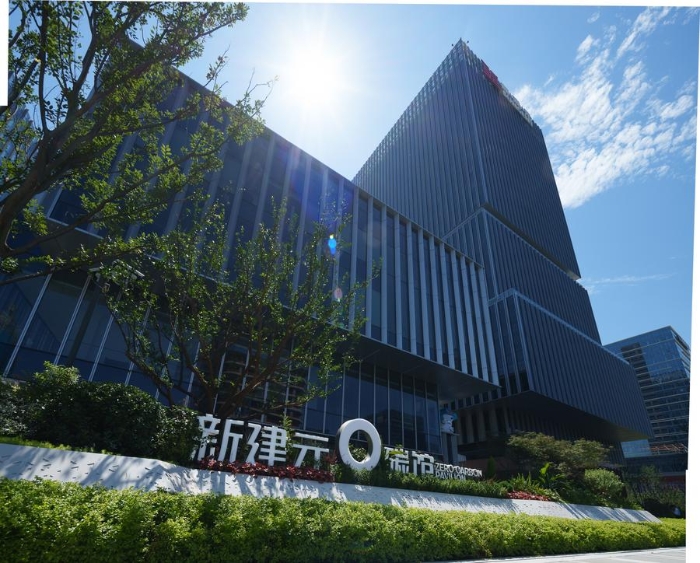China's zero-carbon industrial parks light way to greener future
2025-04-23 09:00:23 | Author:xinhua | Source:xinhua 2025-04-22
* China's Central Economic Work Conference, held in December last year, called for ramped-up efforts to promote a green transition across all sectors, including the establishment of a group of zero-carbon industrial parks. A surge in such parks is expected in 2025.
* Zero-carbon industrial parks not only drive low-carbon development but also enhance enterprises' innovation capability, energy efficiency and informatization level, serving as a key engine for China's high-quality economic growth.
* China has made remarkable progress in its green transition and technologies, and its journey offers a blueprint for sustainable development that other countries can follow.
NANJING, April 22 (Xinhua) -- Along a nearly-500-meter asphalt road shaded by a glimmering canopy of photovoltaic panels, new energy vehicles travel back and forth. Some pull over at the roadside charging station powered by the solar array.
This eco-friendly scene, especially fitting on Tuesday, the 56th Earth Day, is part of a broader zero-carbon initiative at a 100-hectare industrial park in Liyang, a county-level city under Changzhou in east China's Jiangsu Province.
Since beginning operations in June last year, the park has installed around 77,000 square meters of photovoltaic panels, generating 5.2 million kilowatt-hours of green electricity annually. To achieve net-zero carbon emissions, the park is diversifying its clean energy sources to include wind and hydro power, according to Li Jie, general manager of State Grid Liyang Electric Vehicle Service Company, one of the park's key developers.

This photo shows a charging station powered by the solar array at an industrial park in Liyang, a county-level city under Changzhou in east China's Jiangsu Province, April 17, 2025. (Xinhua)
Carbon-free industrial parks aim to achieve zero carbon emissions by integrating clean energy, green architecture, smart management systems and circular economy practices. China's Central Economic Work Conference, which outlined the national priorities for 2025, called for ramped-up efforts to promote a green transition across all sectors, including the establishment of a group of zero-carbon industrial parks.
According to Wu Wei, an associate professor at the China Institute for Studies in Energy Policy at Xiamen University, such parks not only drive low-carbon development but also enhance enterprises' innovation capability, energy efficiency and informatization level, serving as a key engine for China's high-quality economic growth.
ZERO-CARBON PRACTICES POWER AHEAD
According to the city's action plan, Changzhou aims to build more than 10 near-zero-carbon parks and more than 15 near-zero-carbon factories from 2024 to 2026.
Among the pioneers in this plan is Nari-Relays Electric (NR Electric), a local power electronics company. By leveraging AI and cloud computing to monitor and optimize energy use in real time -- from water and electricity consumption to photovoltaic output and environmental conditions -- the company has cut over 21,000 tonnes of carbon dioxide emissions and saved nearly 7,300 tonnes of standard coal since 2023.
Thanks to these efforts, the cost reduction and efficiency improvement have saved NR Electric nearly 20 million yuan (about 2.77 million U.S. dollars), according to the company.
As microgrids are a cornerstone of zero-carbon parks' operation, Changzhou has completed 39 microgrid projects with a total investment of 1.18 billion yuan and plans to construct more such projects in the coming years.

An aerial drone photo taken on March 16, 2025 shows the photovoltaic devices on the roof of the Boao Forum for Asia (BFA) International Conference Center and a BFA hotel in the Boao zero-carbon demonstration zone in Boao, south China's Hainan Province. (Xinhua/Pu Xiaoxu)
Beyond Changzhou, moves to go carbon-free are gaining momentum across China. In 2022, Shanghai released an action plan for a zero-carbon demonstration park in its Minhang District. In 2024, a plan was unveiled to build a zero-carbon park in Beijing's Daxing District. Provinces and regions like Guangxi, Yunnan and Fujian have included zero-carbon park construction in their 2025 government work reports.
China has pledged to peak carbon emissions by 2030 and reach carbon neutrality by 2060. With the advancement of the dual carbon goals, it is expected to see a surge in zero-carbon parks in 2025, said Ding Hong, vice president of Jiangsu's provincial society of the urban economy.
"Advances in distributed solar photovoltaics, energy storage and smart energy management platforms will significantly lower costs of zero-carbon parks' construction and operation, and profoundly change China's energy utilization mode," Ding said.
LOW-CARBON INNOVATIONS GO GLOBAL
In Jiangsu's Suzhou Industrial Park, a joint China-Singapore zero-energy building fitted with rooftop photovoltaic panels, small wind turbines and an AI-controlled lighting and climate system showcases the possibilities of future urban architecture.
Built using sustainable materials, the structure is part of the China-Singapore Green Digital Hub, a 6.7-billion-yuan project launched last November to boost green industries and emerging services.
According to Li Wenjie, deputy director of the institute of urban development at Suzhou Industrial Park, the zero-energy building has been certified by standards organizations in both the United States and Singapore. "This highlights that China's carbon reduction technologies have gained worldwide recognition," he noted.

This photo taken on July 13, 2024 shows a joint China-Singapore zero-energy building in Suzhou Industrial Park in Suzhou, east China's Jiangsu Province. (Xinhua)
China's green technologies are now reaching global markets. NR Electric, for example, has provided energy storage solutions to over 30 countries, including Britain, Japan and Saudi Arabia. At Britain's Richborough Energy Park, its technology has helped reduce carbon emissions by over 10,000 tonnes -- the greatest reduction among all battery energy-storage projects in the country in 2024.
Currently, China is collaborating on green energy projects with over 100 countries and regions. According to the International Renewable Energy Agency, the average global cost per megawatt-hour for wind power has plummeted over the last decade by over 60 percent, and by 80 percent for solar power.
China has made remarkable progress in its green transition and technologies, said Erik Berglof, chief economist at the Asian Infrastructure Investment Bank, during this year's Boao Forum for Asia held in late March. He noted that its journey offers a blueprint for sustainable development that other countries can follow.
(Reporting by Wang Yihan, Chen Shengwei; video reporters: Chen Shengwei, Wang Yihan; video editors: Zhang Mocheng, Zheng Qingbin) ■
